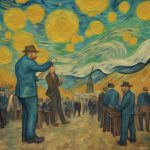Peter Schiff X: Genius Takes or Twitter Nonsense?
April 9, 2025
The Oracle and the Apocalypse
Peter Schiff walks into the room like a prophet wearing a doom-colored tie. A voice for collapse, a seer of systemic sins, he’s been waving the flag of fiscal disaster for decades. Gold evangelist. Dollar skeptic. Inflation hawk. Schiff isn’t playing the short game—he’s narrating the long tragedy of fiat collapse in slow motion. But here’s the question that cuts through the gold-leafed fog: is he a Cassandra cursed always to be right too early, or a bard of financial fiction who turns every correction into confirmation bias?
His predictions read like chapters from Revelations—crashing markets, currency implosions, government debt spirals. He paints an economy on stilts, each monetary policy decision another kick at the hollow legs. And in some ways, he’s not wrong. The system is bloated. The debt is grotesque. The fiat dollar is backstopped by little more than faith and inertia. But here’s the rub—timing is everything, and Schiff’s clock often runs a few cycles ahead of the actual detonation.
Is he wrong—or just early? And does “early” become irrelevant when people go broke shorting the S&P waiting for vindication?
Between Pattern Recognition and Prophecy Addiction
To understand the cult of Peter Schiff X, you have to decode a certain psychological tension: the human need for pattern, narrative, and doom that makes sense of chaos. In that psychic economy, Schiff delivers. He tells a story of consequence. Of karmic collapse. Of economic gravity asserting itself after decades of delusion. There’s a strange comfort in that—especially when reality feels unmoored from reason. He doesn’t just forecast recession; he moralizes it.
But here’s the danger: when forecasts become identity, every deviation becomes betrayal. When the market doesn’t implode as scripted, the narrative doesn’t adjust—the world simply hasn’t caught up yet. Schiff’s predictions start to feel less like economic analysis and more like eschatology. He becomes less of a market analyst and more of a priest.
In a world where financial outcomes are increasingly driven by liquidity, central bank positioning, and crowd emotion—not just balance sheets and fundamentals—this kind of deterministic prophecy can lead investors into traps disguised as convictions. Belief hardens into bias. Doubt is labeled ignorance. And nuance vanishes.
The Gold Gospel and the Dollar Demon
At the heart of Schiff’s worldview is a gleaming golden sun. Gold isn’t just a commodity to him—it’s metaphysical. It’s the antidote to Keynesian sins, the last honest money, the eternal standard. Whenever fiat currencies wobble, he points to the yellow metal like a medieval healer offering alchemical salvation.
But gold hasn’t exactly behaved as a messiah. In real terms, it’s had long periods of stagnation. It pops during panic, sure, but it deflates in complacency. And markets, for better or worse, are optimized for complacency. They’re engineered by institutions with infinite balance sheets, able to suppress volatility with well-timed liquidity injections.
Meanwhile, the dollar—Schiff’s ultimate villain—refuses to die. Like a vampire drawing strength from every crisis, the greenback rises even when its fundamentals falter. It’s not logic—it’s positioning. The dollar is the center of the global liquidity system, and that gravitational pull creates a paradox: the more broken the world is, the stronger the dollar often becomes.
That’s not right—but it’s real. And Schiff’s predictions often underestimate just how long the broken thing can keep running when it owns the monetary narrative.
Schiff vs. the Market Machine
Schiff’s war isn’t just against central banks or Keynesians—it’s against the entire structure of modern markets. The Fed, in his eyes, is a drug dealer. QE is financial fentanyl. Rate suppression is moral decay. And investors? They’re junkies, trading dopamine for fundamentals.
But here’s the problem: he’s not wrong. The Fed has become the largest market maker on Earth. Valuations are unmoored from productivity. And speculation, not savings, is now the prime mover. But again—the question isn’t whether Schiff is right in theory. It’s whether his conclusions are actionable in practice.
Timing the collapse of confidence is like timing a lightning strike during a never-ending thunderstorm. You can smell the ozone. You can feel the static. But the bolt refuses to land. In the meantime, the market keeps ripping, the junkies keep buying dips, and gold underperforms a tech ETF.
That doesn’t invalidate his thesis. But it does raise a brutal truth: Markets don’t reward moral clarity. They reward adaptability. And Schiff’s refusal to play the liquidity game—while noble—makes his analysis less of a tool and more of a monument.
Hype, Heuristics, and the Danger of Righteous Simplicity
There’s something deeply seductive about Schiff’s message. It appeals to a very specific archetype—the Rational Dissident—who sees through the illusion. Who knows the money printer is a lie. Who quotes Mises in Twitter threads and holds gold in a safe? Schiff gives that identity coherence. He gives it drama.
But there’s danger in that coherence. Because it’s often too neat. The world isn’t binary. Inflation isn’t always bad. Deficits aren’t always doom. And markets aren’t moral—they’re reflexive, irrational, and often manipulated.
Schiff’s lens is too tight. It flattens the complexity of global finance into a single, perpetual morality play. And while that might feel like clarity, it’s a kind of blindness. A refusal to engage with the strange truths of this era: that bad policy can produce good trades. That artificial markets can sustain irrational booms. That pessimism, if too constant, becomes its form of delusion.
And delusion, even when dressed in reason, can still bleed you dry.
? Peter Schiff’s Predictions: Scorecard of a Dollar Doom Prophet
| Prediction | Outcome | Verdict |
|---|---|---|
| ? 2006: Warned of a housing bubble and impending collapse of mortgage-backed securities | Housing market crashed in 2007–08; major banks imploded | ✅ Hit |
| ? 2008: Predicted a massive dollar collapse due to Fed’s response to the financial crisis | Dollar strengthened in flight to safety during crisis | ❌ Miss |
| ? 2009: Claimed QE would result in hyperinflation and bond market collapse | Inflation stayed low; bond yields fell | ❌ Wide Miss |
| ? 2010: Forecast gold hitting $5,000+ due to inflation and dollar devaluation | Gold rose, then fell, never touched $3,000 | ⚠️ Partial Miss |
| ? 2011: Said US dollar would crash and lose reserve currency status “very soon” | Dollar rallied; remained global reserve currency | ? Baloney |
| ? 2012: Predicted stock market collapse due to Fed stimulus | S&P entered long bull run post-2012 | ❌ Miss |
| ? 2013: Claimed Bitcoin was a fad and would go to zero | Bitcoin exploded from $100s to $60k+ over time | ? Dead Wrong |
| ? 2015: Warned of imminent rate hike-induced market collapse | Rate hikes began, but markets absorbed them until 2018 | ❌ Miss |
| ? 2016: Predicted Trump’s election would cause a massive recession | Markets surged post-Trump; no recession until COVID | ❌ Wide Miss |
| ? 2018: Said Fed would reverse hikes quickly and markets would crash | Fed paused hikes in 2019, markets surged | ⚠️ Partial Credit |
| ? 2020 (COVID crash): Said it was the beginning of the real collapse he’d been warning about | Fed pumped liquidity, markets recovered rapidly | ❌ Miss |
| ? 2021: Forecast inflation would become uncontrollable and destroy purchasing power | Inflation surged significantly post-2021 | ✅ Hit |
| ? 2022: Said Fed couldn’t raise rates aggressively without crashing everything | Fed raised rates rapidly; no full collapse, but bank stress appeared | ⚠️ Close Call |
| ? 2023: Insisted hyperinflation was inevitable due to deficits and Fed debt monetization | Inflation moderated below peak levels | ❌ Miss |
| ? Repeated: Advocated 100% gold portfolio, called equities a bubble | Gold underperformed equities for a decade+ | ? Stale Take |
| ? Repeated: Predicts every Fed action will lead to dollar collapse | Dollar index remains structurally strong | ? Perma-Miss |
? Analysis: Doom Bias, Echo Chamber, and That One Big Call
- 2008 was his Magnum Opus: Schiff nailed the housing crisis when most were blind. That gave him credibility—but he’s spent the last 15 years trying to relive that prophetic high.
- Timing kills everything: Many of his macro themes sound plausible, but his forecasts lack timing precision. In markets, early is wrong if you’re bleeding capital while waiting for the prophecy to fulfill.
- Perma-bear problem: Like broken clocks, permanent doomsayers will eventually be “right” again—but that doesn’t mean they’re useful in real time.
- Gold addiction: Schiff treats gold like a religion. But gold isn’t immune to real-world market dynamics, and it’s underperformed broader risk assets and even crypto in key cycles.
- Dollar Death Spiral is still missing: For over a decade, he’s called for the dollar’s funeral. Yet it still walks tall. You can hate the system, but if you bet against it without nuance—you get steamrolled.
- Refusal to adapt: He mocks Bitcoin, dismisses tech, and shuns equities. That rigidity makes him more oracle than operator—a warning siren, not a roadmap.
The Cassandra Complex: Right, but Not Useful
The biggest problem with Peter Schiff X predictions isn’t that they’re wrong—it’s that they’re not operational. You can’t build a trading strategy off permanent pessimism. You can’t short the system forever. Eventually, your capital decays while waiting for vindication.
Yes, the debt is unsustainable. Yes, fiat is fragile. Yes, the Fed has created distortions. But none of that tells you what to do tomorrow. Or next quarter. Or when your stop loss gets hit.
Schiff has become a kind of anti-indicator—not because his analysis lacks logic, but because it lacks flexibility. Markets don’t move on truth. They move on perception. They move on to positioning. They move on liquidity. And if you ignore those vectors, you don’t become enlightened—you become irrelevant.
The real edge isn’t knowing the end is coming. It’s knowing how long the lie can last—and learning to profit from it anyway.
Conclusion: Narrative, Noise, and Necessary Heresy
Peter Schiff is necessary. He’s a virus in the system’s code. A reminder that we’re building on sand. A thorn in the side of complacency. But he’s also a cautionary tale about the dangers of turning analysis into identity. The moment your forecast becomes sacred, your vision becomes brittle.
In a world where the truth is volatile, and reality bends under liquidity, you don’t need prophets. You need adaptable heretics—traders and thinkers who can ride the chaos without worshiping it. Who can acknowledge Schiff’s truths without being imprisoned by his timing.
Schiff is part hype. Part fact. Part fiction. Like all narratives, he’s both map and mirage. Learn from him. Don’t become him.











